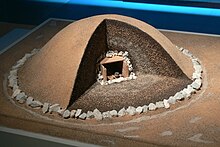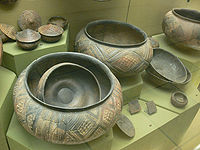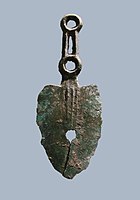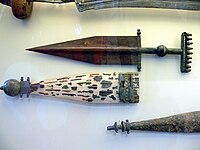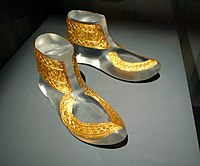The Celts of Hallstat and La Tene.
Celtic Cultures - Hallstatt And La Tene
Hallstatt
Timespan: 1200 BC - 475 BC
Hallstatt culture is characterised in 4 stages, according to James(2005: 21): A & B late Bronze Age, from c 1200 to 700 BC; C Early Iron Age, from c700-600 BC; D from c 600 to 475 BC
 The Hallstatt culture spanned central Europe, with its centre in the area around Hallstatt in Central Austria. There were two distinct cultural zones - the eastern:including Croatia, Slovenia, Western Hungary, Austria, Moravia, and Slovakia; western: including Northern Italy, Switzerland, Eastern France, Southern Germany, and Bohemia (Wikipedia).
The Hallstatt culture spanned central Europe, with its centre in the area around Hallstatt in Central Austria. There were two distinct cultural zones - the eastern:including Croatia, Slovenia, Western Hungary, Austria, Moravia, and Slovakia; western: including Northern Italy, Switzerland, Eastern France, Southern Germany, and Bohemia (Wikipedia).
At the start of the period, long distance trade was already well established in copper and tin - the basic requirements for manufacture of bronze. From about 700 BC, trade in iron also became established. The Hallstat area also already controlled the trade in salt, crucial when there were few other means to preserve food. Control of these two crucial trade goods - iron and salt - provided the basis for the accumulation of wealth and influence. From 800 BC, some burials of rich people can be identified,in central Europe, with grave goods such as wheeled wagons and iron swords.
Hallstatt C saw the construction of fortified hilltop settlements to the North of the Alps. These had burial mounds holding very high quality goods, such as vehicles and expensive imported treasures. By the time of the Hallstatt D period, these increasingly extravagant burial mounds were clustered around a few major hillforts to the southwest of the region. This suggests a development and a concentration of wealth of social power, possibly based on the development of Massilia (present-day Marseilles) as a Greek trading port. The expansion of luxury trade brought greater opportunities for profit and helped to create an increasingly stratified society, with the development of a wealthy nobility (James, 2005: 21).
Over the period from 1846 to 1863, a thousand graves were found at Hallstatt, with an astonishing range of artefacts, including clothing and saltmining equipment as well as weapons, jewellery, pottery and imported bronze vessels in the "chieftains'" graves.
La Tene
Timespan: C 500 BC To C 15 BC
The La Tene era was the time of Celtic expansion and migration and the time of formation of the myths. The La Tene culture is named after the site in Switzerland where it was first discovered. The La Tene people were those known to the Romans as Gauls.
 Originally found in an area from Eastern France to Bohemia, the La Tene culture spread rapidly from about 400 BC. The La Tene Celts settled in Spain in 450 BC, in Northern Italy in 400 BC, invaded Rome in 390 BC, invaded Greece in 279 BC, invaded Galatia (in modern Turkey) in 270 BC. By 200 BC, they occupied the lands that are now Britain, the Netherlands, Brittany, Belgium, Germany and Switzerland.
Originally found in an area from Eastern France to Bohemia, the La Tene culture spread rapidly from about 400 BC. The La Tene Celts settled in Spain in 450 BC, in Northern Italy in 400 BC, invaded Rome in 390 BC, invaded Greece in 279 BC, invaded Galatia (in modern Turkey) in 270 BC. By 200 BC, they occupied the lands that are now Britain, the Netherlands, Brittany, Belgium, Germany and Switzerland.
There is much debate over how much of the expansion into Britain was achieved through either/or invasion and settlement and how much was the expression of cultural transfer that accompanied trade and refelected the commonality of kinship and language of many tribes. There is little evidence for actual migration of La Tene people into Britain (James, 2005: 12). Nevertheless, it does appear that the La Tene culture was more militarily-focused than the Hallstatt one. The La Tene graves across Europe hold iron weapons - swords and spearheads - and wooden shields, as well as everyday items such as razors, yokes, cauldrons and jewellery.
References
- James, S (2005) "Exploring the World of the Celts" Thames and Hudson
- Wikipedia on Hallstatt
- Wikipedia on la Tene
Tags:
Replies to This Discussion
-
Permalink Reply by Ghillie Dhu on June 11, 2018 at 4:54pm
-
Hallstatt culture
From Wikipedia, the free encyclopediaJump to navigationJump to search
Hallstatt culture 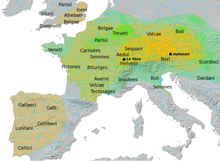
Geographical range Europe Period Iron Age Europe Dates circa 800 BC — circa 500 BC Type site Hallstatt Preceded by Urnfield culture Followed by La Tène culture  Watercolour commissioned by Johann G. Ramsauer documenting one of his cemetery digs at Hallstatt; unknown local artist.
Watercolour commissioned by Johann G. Ramsauer documenting one of his cemetery digs at Hallstatt; unknown local artist.The Hallstatt culture was the predominant Western and Central European culture of Early Iron Age Europe from the 8th to 6th centuries BC, developing out of the Urnfield culture of the 12th century BC (Late Bronze Age) and followed in much of its area by the La Tène culture. It is commonly associated with Proto-Celtic and Celtic populations in the Western Hallstatt zone and with (pre-)Illyrians in the eastern Hallstatt zone.[1]
It is named for its type site, Hallstatt, a lakeside village in the Austrian Salzkammergut southeast of Salzburg, where there was a rich salt mine, and some 1,300 burials are known, many with fine artefacts. Material from Hallstatt has been classed into 4 periods, numbered "Hallstatt A" to "D". Hallstatt A and B are regarded as Late Bronze Age and the terms used for wider areas, such as "Hallstatt culture", or "period", "style" and so on, relate to the Iron Age Hallstatt C and D.
By the 6th century BC, it had expanded to include wide territories, falling into two zones, east and west, between them covering much of western and central Europe down to the Alps, and extending into northern Italy. Parts of Britain and Iberia are included in the ultimate expansion of the culture.
The culture was based on farming, but metal-working was considerably advanced, and by the end of the period long-range trade within the area and with Mediterranean cultures was economically significant. Social distinctions became increasingly important, with emerging elite classes of chieftains and warriors, and perhaps those with other skills. Society was organized on a tribal basis, though very little is known about this. Only a few of the largest settlements, like Heuneburg in the south of Germany, were towns rather than villages by modern standards.
-
-
Permalink Reply by Ghillie Dhu on June 11, 2018 at 4:55pm
-
Hallstatt type site[edit]
In 1846, Johann Georg Ramsauer (1795–1874) discovered a large prehistoric cemetery near Hallstatt, Austria, which he excavated during the second half of the 19th century. Eventually the excavation would yield 1,045 burials, although no settlement has yet been found. This may be covered by the later village, which has long occupied the whole narrow strip between the steep hillsides and the lake. Some 1,300 burials have been found, including around 2,000 individuals, with women and children but few infants.[2] Nor is there a "princely" burial, as often found near large settlements. Instead, there are a large number of burials varying considerably in the number and richness of the grave goods, but with a high proportion containing goods suggesting a life well above subsistence level.
The community at Hallstatt was untypical of the wider, mainly agricultural, culture, as its booming economy exploited the salt mines in the area. These had been worked from time to time since the Neolithic period, and in this period were extensively mined with a peak from the 8th to 5th centuries BC. The style and decoration of the grave goods found in the cemetery are very distinctive, and artifacts made in this style are widespread in Europe. In the mine workings themselves, the salt has preserved many organic materials such as textiles, wood and leather, and many abandoned artefacts such as shoes, pieces of cloth, and tools including miner's backpacks, have survived in good condition.[3]
Finds at Hallstatt extend from about 1200 BC until around 500 BC, and are divided by archaeologists into four phases:
date BC HaA 1200-1000 HaB 1000-800 HaC 800-650 HaD 650-475 Hallstatt A-B are part of the Bronze Age Urnfield culture. In this period, people were cremated and buried in simple graves. In phase B, tumulus (barrow or kurgan) burial becomes common, and cremation predominates. The "Hallstatt period" proper is restricted to HaC and HaD (8th to 5th centuries BC), corresponding to the early European Iron Age. Hallstatt lies in the area where the western and eastern zones of the Hallstatt culture meet, which is reflected in the finds from there.[4] Hallstatt D is succeeded by the La Tène culture.
Hallstatt C is characterized by the first appearance of iron swords mixed amongst the bronze ones. Inhumation and cremation co-occur. For the final phase, Hallstatt D, daggers, almost to the exclusion of swords, are found in western zone graves ranging from c. 600–500 BC.[5] There are also differences in the pottery and brooches. Burials were mostly inhumations. Halstatt D has been further divided into the sub-phases D1-D3, relating only to the western zone, and mainly based on the form of brooches.[5]
Major activity at the site appears to have finished about 500 BC, for reasons that are unclear. Many Hallstatt graves were robbed, probably at this time. There was widespread disruption throughout the western Hallstatt zone, and the salt workings had by then become very deep.[6] By then the focus of salt mining had shifted to the nearby Hallein Salt Mine, with graves at Dürrnberg nearby where there are significant finds from the late Hallstatt and early La Tène periods.
Much of the material from early excavations was dispersed,[2] and is now found in many collections, especially German and Austrian museums, but the Hallstatt Museum in the town has the largest collection.
- Finds from the Hallstatt site
-
-
Permalink Reply by Ghillie Dhu on June 14, 2018 at 2:18pm
-
Well Elspeth they also cremated the dead as well as buriala, so maybe the chidren were cremated exclusivly for some reason or else there are finds still to come to liht.
-
-
Permalink Reply by Ghillie Dhu on June 11, 2018 at 5:00pm
-
Culture and trade[edit]
Further information: Greeks in pre-Roman GaulIt is probable[7][8][9] that some if not all of this diffusion took place in a Celtic-speaking context.[10] In northern Italy the Golasecca culturedeveloped with continuity from the Canegrate culture.[11][12] Canegrate represented a completely new cultural dynamic to the area expressed in pottery and bronzework making it a typical western example of the western Hallstatt culture.[11][12]
The Lepontic Celtic language inscriptions of the area show the language of the Golasecca culture was clearly Celtic making it probable that the 13th-century BC precursor language of at least the western Hallstatt was also Celtic or a precursor to it.[11][12] Lepontic inscriptions have also been found in Umbria,[13] in the area which saw the emergence of the Terni culture, which had strong similarities with the Celtic cultures of Hallstatt and La Tène.[14] The Umbrian necropolis of Terni, which dates back to the 10th century BC, was identical under every aspect, to the Celtic necropolis of the Golasecca culture.[15]
Trade with Greece is attested by finds of Attic black-figure pottery in the elite graves of the late Hallstatt period. It was probably imported via Massilia (Marseilles).[16] Other imported luxuries include amber, ivory (Gräfenbühl) and probably wine. Recent analyses have shown that the reputed silk in the barrow at Hohmichele was misidentified. Red kermes dye was imported from the south as well; it was found at Hochdorf.
The settlements were mostly fortified, situated on hilltops, and frequently included the workshops of bronze-, silver-, and goldsmiths. Typical sites are the Heuneburg on the upper Danube surrounded by nine very large grave tumuli, Mont Lassois in eastern France near Châtillon-sur-Seine with, at its foot, the very rich grave at Vix,[17] and the hill fort at Molpír in Slovakia. Tumuli graves had a chamber, rather large in some cases, lined with timber and with the body and grave goods set about the room.
In the central Hallstatt regions toward the end of the period (Ha D), very rich graves of high-status individuals under large tumuli are found near the remains of fortified hilltop settlements. There are some chariot burials, including (possibly) Býčí Skála,[18] Vix and Hochdorf.[19] A model of a chariot made from lead has been found in Frögg, Carinthia, and clay models of horses with riders are also found. Wooden "funerary carts", presumably used as hearses and then buried, are sometimes found in the grandest graves. Pottery and bronze vessels, weapons, elaborate jewellery made of bronze and gold, as well as a few stone stelae (especially the famous Warrior of Hirschlanden) are found at such burials.[20]The daggers that largely replaced swords in chief's graves in the west were probably not serious weapons, but badges of rank, and used at the table.[5]
The material culture of Western Hallstatt culture was apparently sufficient to provide a stable social and economic equilibrium. The founding of Marseille and the penetration by Greek and Etruscan culture after ca 600 BC, resulted in long-range trade relationships up the Rhone valley which triggered social and cultural transformations in the Hallstatt settlements north of the Alps. Powerful local chiefdoms emerged which controlled the redistribution of luxury goods from the Mediterranean world that is characteristic of the La Tène culture.
Iron swords appear in the later periods, from the 8th century, with tools coming rather later.[21] Initially iron was rather exotic and expensive, and sometimes used as a prestige material for jewellery. The potter's wheel appears right at the end of the period.[22]
The apparently largely peaceful and prosperous life of Hallstatt D culture was disrupted, perhaps even collapsed, right at the end of the period. There has been much speculation as to the causes of this, which remain uncertain. Large settlements such as Heuneburg and the Burgstallkogel were destroyed or abandoned, rich tumulus burials ended, and old ones were looted. There was probably a significant movement of population westwards, and the succeeding La Tène culture developed new centres to the west and north, their growth perhaps overlapping with the final years of the Hallstatt culture.[6]
Pottery from Heuneburg, Germany
Gold bracelets, Burgundy
Ha D style dagger found in Berkshire, England
Muscle cuirasses & double ridge helmet, Kleinklein, Ha D eastern zone.[23]
-
-
Permalink Reply by Ghillie Dhu on June 11, 2018 at 5:01pm
-
Art[edit]
At least the later periods of Hallstatt art from the western zone are generally agreed to form the early period of Celtic art.[24] Decoration is mostly geometric and linear, and best seen on fine metalwork finds from graves (see above). Styles differ, especially between the west and east, with more human figures and some narrative elements in the latter. Animals, with waterfowl a particular favourite, are often included as part of other objects, more often than humans, and in the west there is almost no narrative content such as scenes of combat depicted. These characteristics were continued into the succeeding La Tène style.[25]
Imported luxury art is sometimes found in rich elite graves in the later phases, and certainly had some influence on local styles. The most spectacular objects, such as the Strettweg Cult Wagon,[26] the Warrior of Hirschlanden and the bronze couch supported by "unicyclists" from the Hochdorf Chieftain's Grave are one of a kind in finds from the Hallstatt period, though they can be related to objects from other periods.[27]
More common objects include weapons, in Ha D often with hilts terminating in curving forks ("antenna hilts").[5] Jewellery in metal includes fibulae, often with a row of disks hanging down on chains, armlets and some torcs. This is mostly in bronze, but "princely" burials include items in gold.
The origin of the narrative scenes of the eastern zone, from Hallstatt C onwards, is generally traced to influence from the Situla art of northern Italy and the northern Adriatic, where these bronze buckets began to be decorated in bands with figures in provincial Etruscan centres influenced by Etruscan and Greek art. The fashion for decorated situlae spread north across neighbouring cultures including the eastern Hallstatt zone, beginning around 600 BC and surviving until about 400 BC; the Vače situla is a Slovenian example from near the final period. The style is also found on bronze belt plates, and some of the vocabulary of motifs spread to influence the emerging La Tène style.[28]
According to Ruth and Vincent Megaw, "Situla art depicts life as seen from a masculine viewpoint, in which women are servants or sex objects; most of the scenes which include humans are of the feasts in which the situlae themselves figure, of the hunt or of war".[29] Similar scenes are found on other vessel shapes, as well as bronze belt-plaques.[30] The processions of animals, typical of earlier examples, or humans derive from the Near East and Mediterranean, and Nancy Sandars finds the style shows "a gaucherie that betrays the artist working in a way that is uncongenial, too much at variance with the temper of the craftsmen and the craft". Compared to earlier styles that arose organically in Europe "situla art is weak and sometimes quaint", and "in essence not of Europe".[31]
Except for the Italian Benvenuti Situla, men are hairless, with "funny hats, dumpy bodies and big heads", though often shown looking cheerful in an engaging way. The Benevenuti Situla is also unusual in that it seems to show a specific story.[32]
Gold shoe plaques from the Hochdorf Chieftain's Grave, Germany, c. 530 BC
Fibula brooch with hanging disks and animal figures, Hallstatt
Replica of the Warrior of Hirschlanden
Detail from the Vače situla, Slovenia
-
-
Permalink Reply by Ghillie Dhu on June 11, 2018 at 5:03pm
-
Geography[edit]
Two culturally distinct areas, an eastern and a western zone are generally recognised.[35] There are distinctions in burial rites, the types of grave goods, and in artistic style. In the western zone, members of the elite were buried with sword (HaC) or dagger (HaD), in the eastern zone with an axe.[24] The western zone has chariot burials. In the eastern zone, warriors are frequently buried with helmet and a plate armour breastplate.[23]Artistic subjects with a narrative component are only found in the east, in both pottery and metalwork.[36] In the east the settlements and cemeteries can be larger than in the west.[24]
The approximate division line between the two subcultures runs from north to south through central Bohemia and Lower Austria at about 14 to 15 degrees eastern longitude, and then traces the eastern and southern rim of the Alps to Eastern and Southern Tyrol.[citation needed]
Western Hallstatt zone[edit]
Taken at its most generous extent, the western Hallstatt zone includes:
- northeastern France: Champagne-Ardenne, Lorraine, Alsace
- northern Switzerland: Swiss plateau
- Southern Germany: much of Swabia and Bavaria
- western Czech Republic: Bohemia
- western Austria: Vorarlberg, Tyrol, Salzkammergut
More peripheral areas were:
- Central and North Italy: Po valley, Liguria, Venetia, Marche, Abruzzo, Friuli
- northern and central Spain: Galicia, Asturias, Castile, Cantabria
- northern and north-central Portugal: Minho, Douro, Tras-os-Montes, Beira Alta
While Hallstatt is regarded as the dominant settlement of the western zone, a settlement at the Burgstallkogel in the central Sulm valley (southern Styria, west of Leibnitz, Austria) was a major centre during the Hallstatt C period. Parts of the huge necropolis (which originally consisted of more than 1,100 tumuli) surrounding this settlement can be seen today near Gleinstätten, and the chieftain's mounds were on the other side of the hill, near Kleinklein. The finds are mostly in the Landesmuseum Joanneum at Graz, which also holds the Strettweg Cult Wagon.
Eastern Hallstatt zone[edit]
The eastern Hallstatt zone includes:
- eastern Austria: Lower Austria, Upper Styria
- eastern Czech Republic: Moravia
- southwestern Slovakia: Danubian Lowland
- western Hungary: Little Hungarian Plain
- eastern Slovenia: Hallstatt Archaeological Site in Vače (at the border between Lower Styria and Lower Carniola regions), Novo Mesto
- northern Croatia: Hrvatsko Zagorje, Istria
- northern and central Serbia
- parts of southwestern Poland
Trade, cultural diffusion, and some population movements spread the Hallstatt cultural complex (western form) into Britain, and Ireland.
-
-
Permalink Reply by Ghillie Dhu on June 11, 2018 at 5:05pm
-

-
-
Permalink Reply by Ghillie Dhu on June 11, 2018 at 5:06pm
-

-
Have questions?
Need help? Visit our Support Group for help from our friendly Admins and members!
Have you?
Donations & Sponsorship
Connect
Visit The Temple
on Facebook:
Blog Posts
DO YOU REMEMBER?
Posted by Rosey Cross on March 13, 2025 at 5:28pm 0 Comments 1 Like
WHAT HAS HAPPENED TO US?
Posted by Rosey Cross on March 1, 2025 at 6:36pm 0 Comments 0 Likes
INTERTANTRIC!
Posted by Rosey Cross on February 26, 2025 at 6:18pm 0 Comments 0 Likes
Blessed Imbolc
Posted by Zhan on January 30, 2025 at 9:44pm 0 Comments 2 Likes
Channeled Angelic Wisdom of the Jewels of Truth Series on Free Will and Sublime Gratitude
Posted by Atrayo on January 28, 2025 at 4:19pm 0 Comments 1 Like
CHAOTIC PEACE?
Posted by Rosey Cross on January 26, 2025 at 5:58pm 0 Comments 1 Like
HEART CHAKRA GREEN!
Posted by Rosey Cross on January 26, 2025 at 5:51pm 0 Comments 1 Like
Channeled Angelic Wisdom of the Jewels of Truth Series on Omni-Lives and The God Spark Within
Posted by Atrayo on January 25, 2025 at 3:05pm 0 Comments 1 Like
OUR TIME!!!
Posted by Rosey Cross on January 15, 2025 at 5:29pm 0 Comments 1 Like
THE SACRED ROSE!
Posted by Rosey Cross on January 14, 2025 at 6:21pm 0 Comments 1 Like
ENOUGH! TIME TO SPEAK!
Posted by Rosey Cross on January 10, 2025 at 5:17pm 0 Comments 1 Like
POMBAGIRA MARIA PADILLA a.k.a. Pomba-Gira Maria Padilha
Posted by Sky a.k.a. JD Aeon on January 1, 2025 at 7:29am 7 Comments 1 Like
Happy New Year 2025
Posted by Zhan on December 31, 2024 at 12:04pm 0 Comments 1 Like
Channeled Angelic Wisdom of the Jewels of Truth Series on Beyond Good & Evil and Why Souls Are Reborn
Posted by Atrayo on December 31, 2024 at 1:30am 0 Comments 2 Likes
The Reason for the Season
Posted by Zhan on December 21, 2024 at 12:08pm 1 Comment 1 Like
BEAUTY AND BLISS!
Posted by Rosey Cross on December 9, 2024 at 6:13pm 0 Comments 0 Likes
IGLO
Posted by Rosey Cross on December 9, 2024 at 6:08pm 0 Comments 0 Likes
TORN AND PIERCED!
Posted by Rosey Cross on December 9, 2024 at 5:59pm 0 Comments 0 Likes
777
Posted by Rosey Cross on December 7, 2024 at 2:01pm 0 Comments 2 Likes
NOVEMBER AWARENESS
Videos
-
Two Become One
Added by Imelda James 0 Comments 0 Likes
-
You and I Love
Added by Imelda James 0 Comments 0 Likes
© 2025 Created by Bryan
Powered by
![]()



